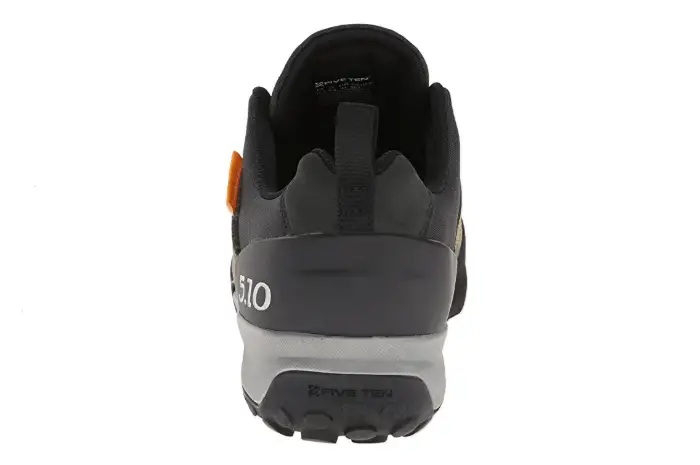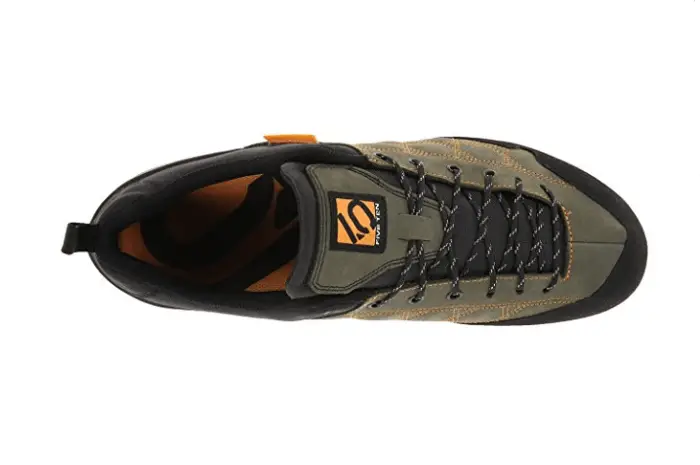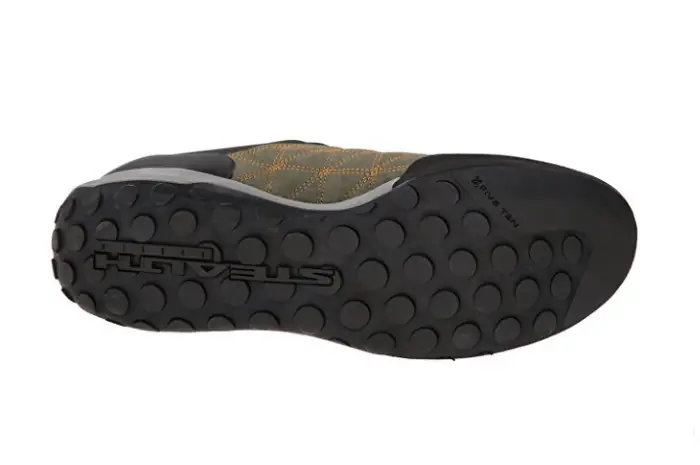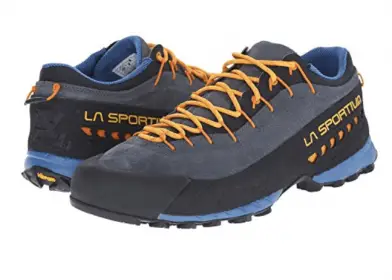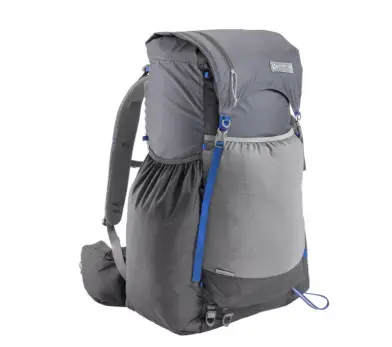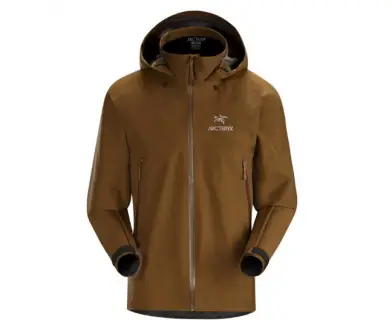Five Ten Guide Tennie
Five Ten Guide Tennie Review Facts
The Five Ten Guide Tennie is a classic approach shoe that for the most part has defined the way people think about approach shoes. It’s a favorite among expert climbers and beginners alike, and its lightweight construction and easy stability make for an easier trek overall. Not surprisingly, the people over at Five Ten are constantly updating and improving their product, and we decided to take a closer look at the shoes latest incarnation.
Editor's Pros & Cons
Pros
- Excellent for crack climbing, smearing and edging
- Performs well on technical climbs
- Stealth C-4 Rubber outsole provides fantastic sticking power.
Cons
- Could be a bit lighter
- Somewhat bulky and not exactly suitable for scrambling.
- Doesn’t allow a whole lot of sensitivity
- Significant break in period
- Fit not always true to size
Outsole
This shoe features what has been dubbed the Stealth C4 outsole that provides a great overall gripping power, yet still allows the user to smear along climbing walls and edges with relative ease. The toe box is unusual in its roominess, allowing for great grip in crag climbing situations, and circular pattern on the bottom of the shoe allows for a more even distribution of the grip while climbing.
One other difference between this approach shoe and a few others is the lack of foam material between the molded EVA mid-sole and the rubberized outsole area. While this design was clearly made to help to decrease the overall weight of the shoe, it didn’t really have the desired effect. The combined areas between the mid-sole and outsole area actually increased the overall bulkiness and weighty feel and shoe.
One other difference between this approach shoe and a few others is the lack of foam material between the molded EVA mid-sole and the rubberized outsole area. While this design was clearly made to help to decrease the overall weight of the shoe, it didn’t really have the desired effect. The combined areas between the mid-sole and outsole area actually increased the overall bulkiness and weighty feel and shoe.
Midsole
The mid-sole area of this particular approach shoe is fairly stiff. Constructed out of compression molded EVA material, much of the overall support and stability in the shoe is located here. Another difference between this shoe and other approach shoe is that while others will often insert a bit of foam in the mid-sole for added comfort, the Five Ten Guide shoe chose to meld the mid sole and the outer sole together into one piece. While this does add to the overall stability and support, quite a few customers found it to make the shoe entirely too bulky for finite control.
Upper
The upper portion of this approach shoe is constructed of a micro-suede material that stands up relatively well to the elements, and allows water to bead off fairly readily. It offers a moderate amount of breathability and comfort, but does require a fair amount of routine care to keep in good condition.
However, the material doesn’t always allow for the most comfort on longer approaches, especially when moving through significant amounts of dirt and debris. Smaller particles tend to get caught in the pore spaces and clog up the shoes, leading to greater perspiration over time.
However, the material doesn’t always allow for the most comfort on longer approaches, especially when moving through significant amounts of dirt and debris. Smaller particles tend to get caught in the pore spaces and clog up the shoes, leading to greater perspiration over time.
Breathability
Considering it’s heavy overall construction, this shoe offers a remarkable amount of ventilation, especially in the upper portion of the shoe. The suede material breathes easily and allows a good bit of airflow to the top portion of the foot.
It should be noted, however, that on longer treks, especially during approaches with a fair amount of dust and debris, the suede upper portions were shown to decrease their ventilation somewhat, most likely due to fine particles getting stuck in the pore spaces of the material. Many customers did complain about their feet becoming overheated even before they reached their climbing destination.
Another area that was a bit of a disappointment when it came to breathability was the lower portion of the shoe. While most people liked the overall protection and durability offered from the combined mid-sole and outsole areas of this shoe, they also noted that the increased amount of molded rubberized material leads to an increase in overall perspiration, especially in the ankle and arch areas of the foot.
It should be noted, however, that on longer treks, especially during approaches with a fair amount of dust and debris, the suede upper portions were shown to decrease their ventilation somewhat, most likely due to fine particles getting stuck in the pore spaces of the material. Many customers did complain about their feet becoming overheated even before they reached their climbing destination.
Another area that was a bit of a disappointment when it came to breathability was the lower portion of the shoe. While most people liked the overall protection and durability offered from the combined mid-sole and outsole areas of this shoe, they also noted that the increased amount of molded rubberized material leads to an increase in overall perspiration, especially in the ankle and arch areas of the foot.
Comfort
Most people found these shoes to be fairly comfortable when it came to hiking or face climbing. There are seven lace eyelets that allow for a much more customized fit, although quite a few users found that the thin laces were a bit bothersome, especially if trying to tie them with sweaty hands. The gusseted tongue is a nice addition that helps to keep the finer particles and dust away from the feet.
Unfortunately, these shoes are known for having a significant break in period, usually taking a few treks or approaches to fully get comfortable. Quite a few users found that it was necessary to use them on three or four long approaches before they truly got comfortable, and even then, blisters were likely to occur at some point.
Unfortunately, these shoes are known for having a significant break in period, usually taking a few treks or approaches to fully get comfortable. Quite a few users found that it was necessary to use them on three or four long approaches before they truly got comfortable, and even then, blisters were likely to occur at some point.
Style
The Five Ten Guide Tennie approach shoe has a fairly straightforward and classic style and fit overall. The shoe sits relatively low on the heel and ankle, mimicking most athletic shoes in its cut and overall style. While the shoe can be easily worn in an urban setting and mistaken for a normal athletic shoe quite easily, the overall style does not lend itself to adequate protection, especially while scrambling through a field of boulders, or on a long approach.
Durability
One of the great things about this approach shoe from Five Ten is the level of durability and quality construction that you’ll find. Areas such as the toe box, ankle area, and the sole area are protected by thick rubberized armor, which provided a significant amount of protection from abrasion and longevity overall. The suede upper portion was also relatively thick, and the stitching was tightly packed and well done.
The Five Ten Guide Tennie is well known for their overall ability to last through rough terrain for quite a few years, and this shoe is no exception.
The Five Ten Guide Tennie is well known for their overall ability to last through rough terrain for quite a few years, and this shoe is no exception.
Protection
Given the relatively low profile, this shoe offers a moderate amount of protection overall. The suede upper portion and the tough rubberized sole provide a good bit of protection from the elements, but the overall profile does decrease the overall level of protection, especially in the upper ankle area.
When it comes to protection, however, this shoe excels in protecting the bottom portion of the foot and toe area while still providing great overall sensitivity and responsiveness while climbing. The thick rubber sole and toe shield provided great protection from abrasion. Also, the molded EVA mid-sole material offered a fair amount of control and protection from the occasional twists that are sometimes experienced during climbing.
When it comes to protection, however, this shoe excels in protecting the bottom portion of the foot and toe area while still providing great overall sensitivity and responsiveness while climbing. The thick rubber sole and toe shield provided great protection from abrasion. Also, the molded EVA mid-sole material offered a fair amount of control and protection from the occasional twists that are sometimes experienced during climbing.
Responsiveness
Overall, the Five Ten Guide Tennie provided us with a mix bag when it came to responsiveness. It was a fantastic choice when it came to smearing, edging or general technical climbing, due to the powerful grip strength of the toe box and tread. However, the bulky nature of the thick outer sole that was merged with the stiff mid-sole area meant that the overall feel of the shoe was, well to put it mildly, a bit cumbersome.
Another area in which the shoe could definitely be improved overall was the general sensitivity of the shoe itself. While the toe box area and tread provided great grip strength and sensitivity when it came to smearing, the relatively bulky nature of the shoe didn’t help edging. It was fairly easy to find the areas of the rock that would provide the best toe holds and crack for a secure climb; making sure that you knew that your foot was secure in those places without visual confirmation was a different story.
Another area in which the shoe could definitely be improved overall was the general sensitivity of the shoe itself. While the toe box area and tread provided great grip strength and sensitivity when it came to smearing, the relatively bulky nature of the shoe didn’t help edging. It was fairly easy to find the areas of the rock that would provide the best toe holds and crack for a secure climb; making sure that you knew that your foot was secure in those places without visual confirmation was a different story.
Support
Truth be told, these shoes weren’t found to be too spectacular when it came to the support category. Although the merged mid-sole and outsole portions of the shoe certainly provided a decent amount of added weight, quite a few found that the overall support provided didn’t quite match the amount of material in the shoe.
Traction
The tread on this shoe is somewhat unique when it comes to approach shoe. Where many other approach shoes choose to try to find a tread that will serve well both in the approach and the climb, the Five Ten Guide Tennie appears to focus more on the climb and gripping the rock face overall. The circular tread allows for phenomenal grip strength that is perfect for smearing, crack climbing, and edging.
However, when it comes to getting to the rock face, there are better choices out there. The tread does lend itself to slippage especially on wet terrain, leaves, or loose soil. If you live in areas where climbing in inclement weather or the results of such weather is a possibility, you may want to use a shoe with a different tread.
However, when it comes to getting to the rock face, there are better choices out there. The tread does lend itself to slippage especially on wet terrain, leaves, or loose soil. If you live in areas where climbing in inclement weather or the results of such weather is a possibility, you may want to use a shoe with a different tread.
Price
These shoes can be found at most outlets to range in price between $110 and $130 USD, which does put them in the moderately high to high price range when it comes to approach shoes. Overall for what you get, the investment in these shoes is a respectable one, but there are other options out there that have a lighter overall feel and are a bit more versatile in the same price range or even less.
Comparison To Other Brands
The Five Ten Guide Tennie is one of the mainstays for most climbers for approach shoes, and with good reason. Even with its faults, and it does have quite a few, it still out performs and outlasts many of it’s competitors on the market today. When it comes to climbing, it can easily out pace both the La Sportiva TX2, and the Gecko brands, both of which are highly regarded in their own right.
It’s doesn’t fair as well in the area of hiking comfort, mainly because of the weight and bulkiness, but still lands squarely in the top ten on that criteria as well. However, when it comes to durability and longevity, these shoes again lead the pack with their quality construction and great materials.
It’s doesn’t fair as well in the area of hiking comfort, mainly because of the weight and bulkiness, but still lands squarely in the top ten on that criteria as well. However, when it comes to durability and longevity, these shoes again lead the pack with their quality construction and great materials.
Performance
If you’re looking for an approach shoe that offers great control while on the rock face, or cliff, you really can’t do any better than the Five Ten Guide Tennie. The roomy toe box, flexible framework and the unique tread allow for fantastic edging, smearing and gripping on nearly any type of climbing surface.
However, this is not the best approach shoe to use on the actual approach, especially if it’s a longer trek. The shoe itself is somewhat on the heavy side, and the tread, which is great for gripping the rock face, doesn’t really do very well on looser material such as gravel or dirt.
However, this is not the best approach shoe to use on the actual approach, especially if it’s a longer trek. The shoe itself is somewhat on the heavy side, and the tread, which is great for gripping the rock face, doesn’t really do very well on looser material such as gravel or dirt.
The Bottom Line
When it comes to a general approach shoe, the Five Ten Guide Tennie delivers moderately well, but with a few caveats. It’s a great overall choice when it comes to the actual climb, out performing most competitors when it came to smearing, edging and crack climbing. However, when it came to scrambling over boulders or hiking to the climbing location, many users found the shoes bulky nature and overall stiffness left their feet a bit sore and tired.
The shoe was also shown to be a bit ill fitting, and required a significant amount of break-in time, which was a bit of a disappointment, considering that it is moderately expensive when it comes to approach shoes.
Does the benefits of the Five Ten Guide Tennie shoes outweigh the faults? It really depends on what you have in mind for their use. If your approaches are relatively short, and your climbs are technical in nature, this shoe is absolutely awesome to have. However, if you know that you’ll spend more time hiking and scrambling to get to that technical climb, these shoes are probably not the best choice overall.
The shoe was also shown to be a bit ill fitting, and required a significant amount of break-in time, which was a bit of a disappointment, considering that it is moderately expensive when it comes to approach shoes.
Does the benefits of the Five Ten Guide Tennie shoes outweigh the faults? It really depends on what you have in mind for their use. If your approaches are relatively short, and your climbs are technical in nature, this shoe is absolutely awesome to have. However, if you know that you’ll spend more time hiking and scrambling to get to that technical climb, these shoes are probably not the best choice overall.







